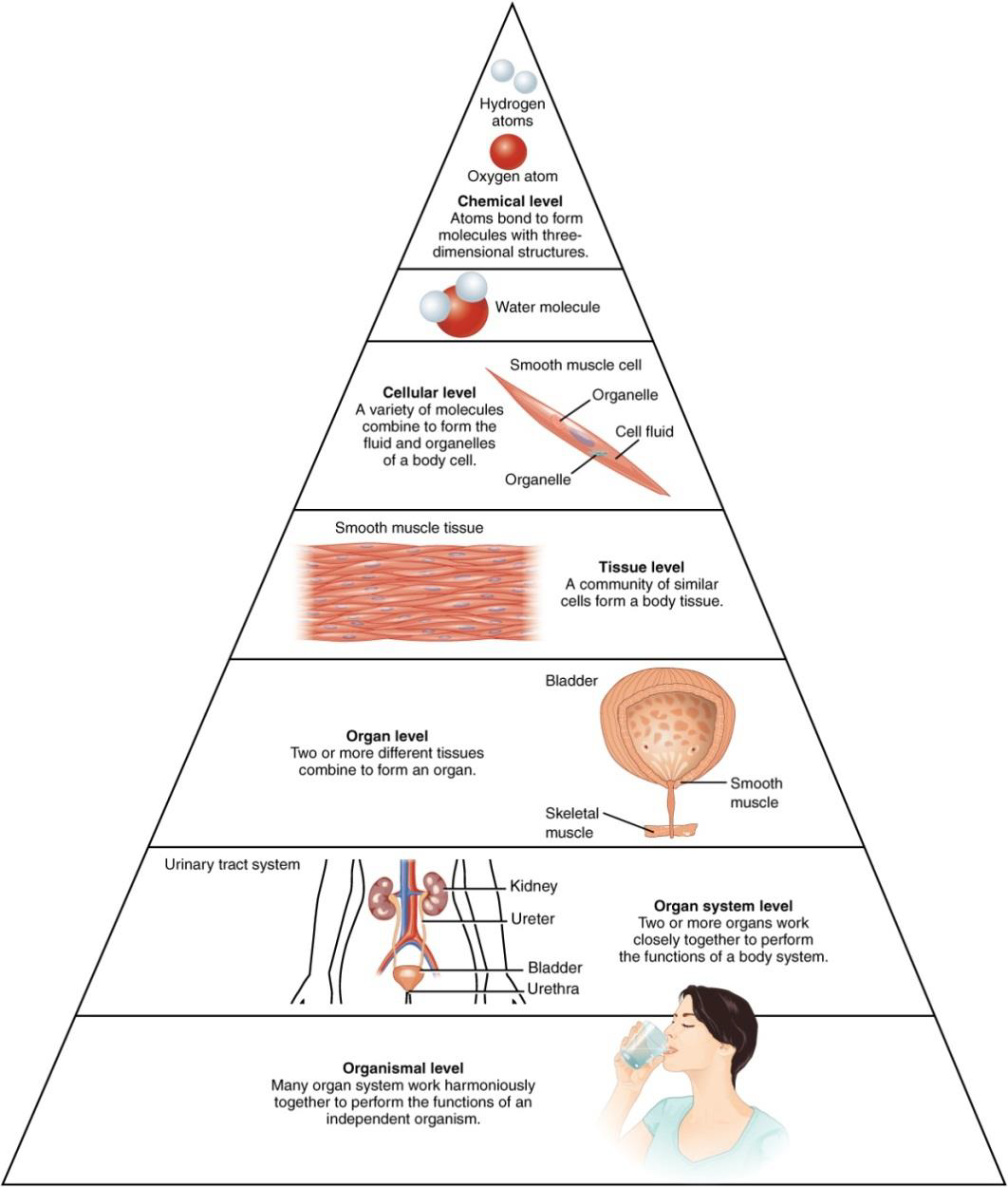1.1: Levels of Organization of the Human Organism
- Page ID
- 11097
learning objectiveS
- Describe, in order from simplest to most complex, the major levels of organization in the human organism
All living and non-living things are made of one or more unique substances called elements, the smallest unit of which is the atom, (for example, the element oxygen (O) is made of O atoms, carbon (C) is made of C atoms and hydrogen (H) is made of H atoms. Atoms combine to form molecules. Molecules can be small (for example, O2, oxygen gas, which has 2 atoms of the element O; CO2, carbon dioxide, which has 1 atom of C and 2 of O), medium (for example, C6H12O6, glucose, which has 6 atoms of C, 12 of H, and 6 of O); or large (for example molecules called proteins are made of hundreds of atoms of C, H, and O with other elements such as nitrogen (N). Molecules are the building blocks to all structures in the human body.
All living structures are made of cells, which are made of many different molecules. Cells are the smallest independent living thing in the human body. The body is made of many different cell types, each with a particular function, (for example muscle cells contract to move something, and red blood cells carry oxygen). All human cells are made of a cell membrane (thin outer layer) that encloses a jelly-like cellular fluid containing tiny organ-like
structures called organelles. There are many types of organelles, each with a particular function (for example, organelles called mitochondrion provides energy to a cell). Different types of cells contain different amounts and types of organelles, depending on their function, (for example muscle cells use a lot of energy and therefore have many mitochondria while skin cells do not and have few mitochondria).
As in other multicellular organisms, cells in the human body are organized into tissues. A tissue is a group of similar cells that work together to perform a specific function. There are four main tissue types in humans (muscular, epithelial, nervous and connective). An organ is an identifiable structure of the body composed of two or more tissues types (for example, the stomach contains muscular tissue made of muscle cells, which allows it to change its shape, epithelial tissue which lines both the inner and outer surface of the
stomach, nervous tissue which sends and receives signals to and from the stomach and the central nervous system, and connective tissue which binds everything together). Organs often perform a specific physiological function (for example, the stomach helps digest food). An organ system is a group of organs that work together to perform a specific function (for example, the stomach, small and large intestines are all organs of the digestive system, that work together to digest foodstuff, move nutrients into the blood and get rid of waste). The most complex level of organization, the human organism is composed of many organ systems that work together to perform the functions of an
independent individual.
Summarizing:
The major levels of organization in the body, from the simplest to the most complex are: atoms, molecules, organelles, cells, tissues, organs, organ systems, and the human organism. See below Figure \(\PageIndex{1}\) .

Figure \(\PageIndex{1}\) Hierarchical levels of organization of the human body from the smallest chemical level to the largest organismal level. Read the description, and examples for each level in the pyramid: Chemical level, Cellular level, Tissue level, Organ level, Organ system level, and Organismal level.
Concepts, Terms, and facts check
Study Questions Write your answer in a sentence form (do not answer using loose words)
1. What is an element?
2. What is an atom?
3. What is a molecule?
4. What is a cell?
5. What is an organelle?
6. What is a tissue?
7. What is an organ?
8. What is an organ system?
9. What is an organism?
10. What are the levels of organization in the human organism (list them from the smallest to the largest)?

